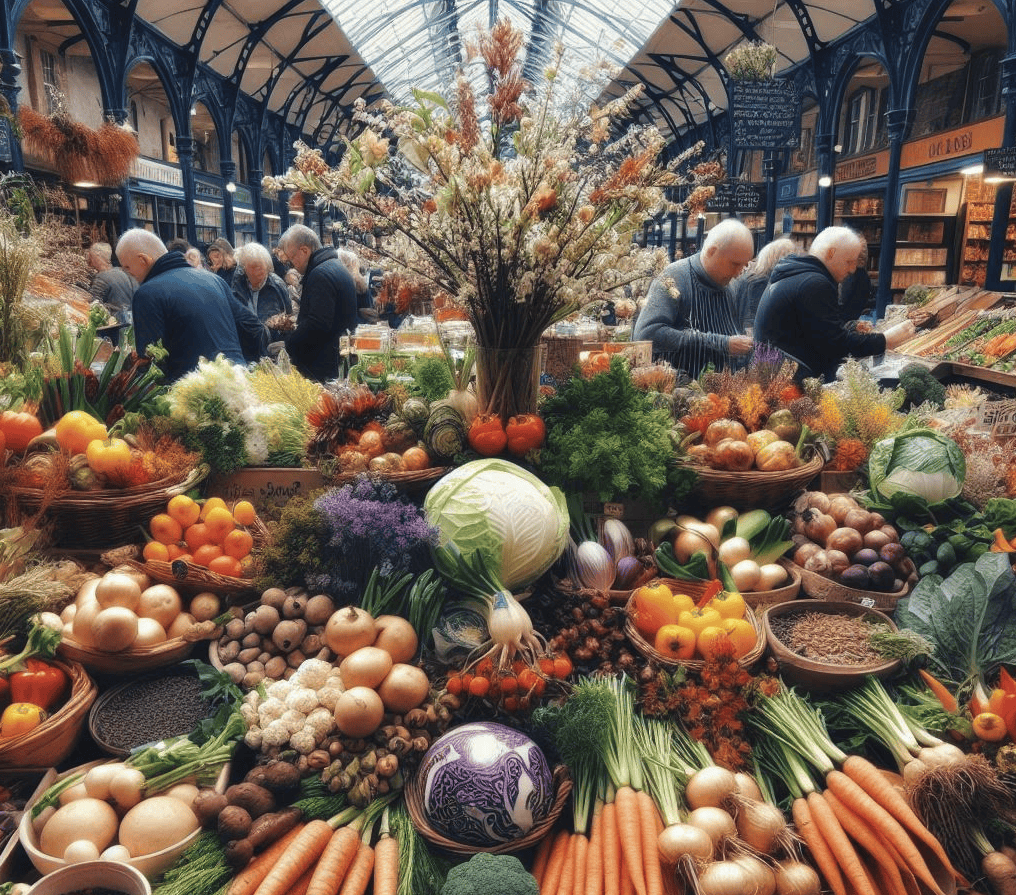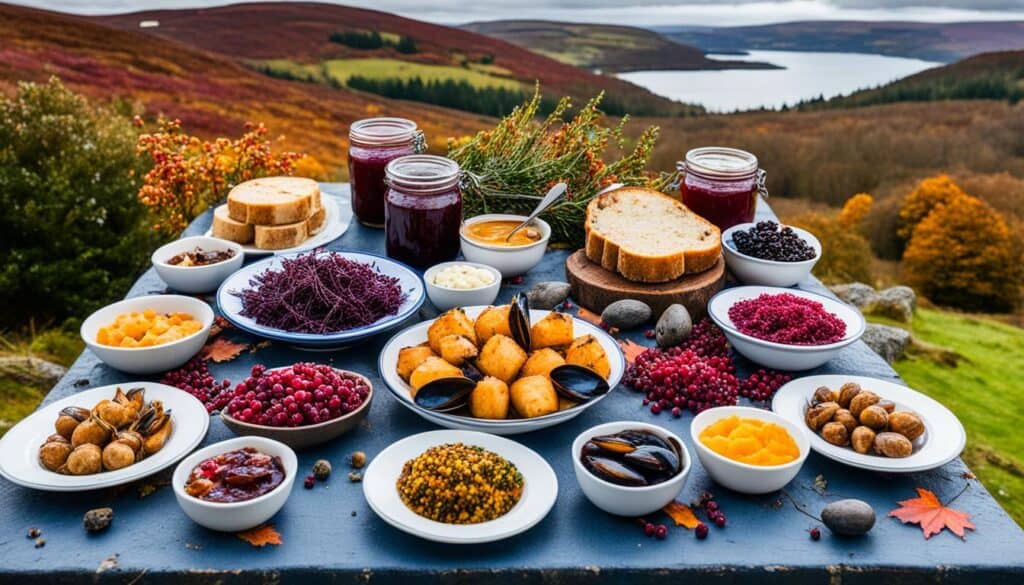
Imagine yourself wandering through a lively farmers’ market in the center of Edinburgh. The air is alive with the buzz of cheerful vendors and the delicious scent of fresh, locally-grown produce. As you take in the colorful displays of ripe fruits and vegetables, you might ask, “What’s in season at the moment?”
🏴 Scotland is a country that takes immense pride in its culinary heritage, and a significant part of that pride stems from its commitment to using seasonal ingredients. But why is eating seasonal food so important?
For starters, it supports local farmers and reduces the carbon footprint of transporting out-of-season produce from far-off places. Plus, fruits and vegetables picked at the peak of their season are bursting with flavor and nutrients.
Did you know that the average distance food travels from farm to plate in the UK varies widely, especially due to the high proportion of imported food? By choosing seasonal and local produce, you can help reduce food miles and contribute to a more sustainable food system.
So, are you ready to embark on a culinary journey through the seasons in Scotland? From the tender asparagus of spring to the hearty root vegetables of winter, each season brings its own unique flavors and ingredients to the Scottish table.
Let’s explore the delicious world of seasonal food in Scotland together!
Spring Seasonal Food in Scotland
As the winter chill gives way to the gentle warmth of spring, Scotland’s countryside comes alive with a bounty of fresh produce. From the first tender shoots of asparagus to the tangy sweetness of rhubarb, spring offers a delightful array of flavors for food enthusiasts to explore.
Vegetables and Fruits
Asparagus, often referred to as the “king of vegetables,” is one of the most anticipated spring delicacies in Scotland. These slender, green spears are harvested from late April to June and are prized for their delicate flavor and versatility in cooking. Whether grilled, roasted, or sautéed, asparagus pairs beautifully with a variety of dishes, from light salads to hearty pasta.
Rhubarb, another spring favorite, adds a delightful tartness to desserts and jams. This vibrant red vegetable (yes, it’s technically a vegetable!) is often paired with strawberries in classic Scottish desserts like crumbles and tarts. Rhubarb is also used to make refreshing cordials and cocktails, perfect for sipping on a warm spring evening.
Wild garlic, or ramsons, is a pungent and flavorful herb that grows abundantly in Scotland’s woodlands during spring. Its delicate white flowers and bright green leaves are a welcome sight for foragers and food lovers alike. Wild garlic adds a delicious, garlicky twist to pestos, soups, and sauces, and can be used as a tasty substitute for regular garlic in many recipes.
| Spring Vegetable | Season | Cooking Methods | Pairing Suggestions |
|---|---|---|---|
| Asparagus | Apr – Jun | Grilled, roasted, sautéed, steamed | Hollandaise sauce, lemon, parmesan cheese |
| Rhubarb | Apr – Jun | Stewed, baked, poached | Strawberries, cream, ginger, vanilla |
| Wild Garlic | Mar – May | Raw, pesto, soup, sauce | Pasta, risotto, fish, eggs |
Seafood
Spring is an excellent time for seafood lovers in Scotland. Salmon, one of the country’s most iconic fish, is at its best during this season. Scottish salmon is renowned for its rich, buttery flavor and tender texture. Whether smoked, grilled, or poached, salmon is a versatile ingredient that can be enjoyed in a variety of dishes, from light salads to indulgent pasta.
Oysters are another springtime delicacy in Scotland. These briny mollusks are harvested from the country’s pristine coastal waters and are prized for their delicate flavor and creamy texture. Oysters are often enjoyed raw, with just a squeeze of lemon or a dash of tabasco sauce, but they can also be grilled or baked for a delightful twist.
For those who prefer a more sustainable seafood option, hand-dived scallops are a great choice. These sweet, succulent shellfish are carefully harvested by divers who ensure minimal damage to the seabed and surrounding marine life. Scottish scallops are at their best in spring and are often served simply seared with butter and herbs, allowing their natural flavor to shine through.
Lamb
Spring is the perfect time to enjoy tender, succulent lamb in Scotland. Lambs are born in the early months of the year and are reared on the country’s lush, green pastures, resulting in meat that is flavorful and delicate.
One of the most popular ways to enjoy spring lamb in Scotland is in a classic roast dinner. A leg of lamb, studded with garlic and rosemary, is a favorite for Sunday lunches and special occasions. The meat is cooked until it’s perfectly pink and juicy, and served with crispy roast potatoes, seasonal vegetables, and a rich gravy.
Lamb is also delicious in stews and casseroles, where it’s slow-cooked until meltingly tender. Scottish lamb stew, made with tender chunks of lamb, potatoes, carrots, and a flavorful broth, is a hearty and comforting dish that’s perfect for chilly spring evenings.
For a lighter take on spring lamb, try grilling lamb chops or kebabs. These quick-cooking cuts are perfect for outdoor barbecues and can be seasoned with a variety of herbs and spices.

Summer Seasonal Food in Scotland
As the days grow longer and the sun shines brighter, Scotland’s summer season brings forth a delightful array of fresh produce. From juicy berries to tender vegetables, the warm months offer a wealth of flavors for food lovers to savor.
Berries
Summer in Scotland is synonymous with an abundance of sweet, juicy berries. Strawberries, raspberries, and blackberries are among the most popular and eagerly anticipated fruits of the season. These delicate berries are bursting with flavor and are perfect for enjoying fresh, baked into desserts, or preserved as jams and jellies.
Scottish strawberries are particularly renowned for their exceptional taste and quality. The long summer days and cool nights provide ideal growing conditions, resulting in berries that are sweet, fragrant, and deeply red. Enjoy them on their own, dipped in chocolate, or as part of a classic dessert like strawberry shortcake or Eton mess.
Raspberries and blackberries are equally delightful and versatile. These tart, juicy berries are perfect for making summer puddings, crumbles, and tarts. They also make excellent additions to breakfast dishes like pancakes, waffles, and smoothie bowls. For a truly Scottish twist, try making a traditional cranachan, a dessert that combines raspberries, whipped cream, honey, and toasted oats.
| Berry | Peak Season | Flavor Profile | Pairing Suggestions |
|---|---|---|---|
| Strawberry | Jun – Aug | Sweet, fragrant | Cream, chocolate, vanilla, balsamic vinegar |
| Raspberry | Jul – Sep | Tart, juicy | Chocolate, lemon, almond, whisky |
| Blackberry | Jul – Sep | Sweet, slightly tart | Apple, cinnamon, ginger, yogurt |
Vegetables
Summer in Scotland yields a bounty of fresh, tender vegetables that are perfect for light, seasonal dishes. Peas, broad beans, and courgettes (zucchini) are among the most anticipated and flavorful offerings.
Peas are a quintessential summer vegetable in Scotland, and there’s nothing quite like the sweet, delicate flavor of freshly-picked peas. Whether enjoyed on their own as a simple side dish or incorporated into salads, pastas, and risottos, peas add a burst of summer freshness to any meal. For a classic Scottish dish, try making a creamy pea and mint soup, perfect for a light summer lunch.
Broad beans, also known as fava beans, are another summer favorite. These large, flat beans have a buttery texture and a slightly nutty flavor that pairs well with a variety of ingredients. Try them in a simple salad with feta cheese, lemon, and herbs, or incorporate them into a hearty summer minestrone soup.
Courgettes, or zucchini, are a versatile summer vegetable that can be enjoyed in countless ways. Grill them with a drizzle of olive oil and a sprinkle of salt for a simple, smoky side dish, or use them in a light, refreshing pasta dish with lemon, garlic, and parmesan. For a delicious vegetarian main course, try stuffing courgettes with a flavorful mixture of quinoa, herbs, and vegetables.
Game
While game is often associated with autumn and winter, summer in Scotland marks the beginning of the grouse shooting season, which starts on August 12th, known as the “Glorious Twelfth.” Grouse, a wild game bird found in Scotland’s heather-clad moors, is prized for its rich, gamey flavor and tender meat.
Grouse is typically roasted whole and served with a variety of accompaniments, such as roasted potatoes, seasonal vegetables, and a rich, flavorful gravy. The bird’s natural flavor is often complemented by the addition of herbs like thyme and rosemary, as well as a splash of whisky or red wine.
For those new to cooking grouse, it’s important to note that the bird has a strong, distinct flavor that may not be to everyone’s taste. To help mellow the gamey notes, try marinating the bird in buttermilk or a mixture of citrus juice and herbs before cooking. This will help to tenderize the meat and balance out the flavors.
Autumn Seasonal Food in Scotland
As the leaves turn golden and the air grows crisp, Scotland’s autumn season ushers in a harvest of hearty, comforting flavors. From earthy root vegetables to succulent game meats, the cooler months offer a wealth of ingredients for food enthusiasts to explore.

Vegetables
Autumn in Scotland is a time for celebrating the humble root vegetable. Potatoes, carrots, and parsnips are at their peak during this season, and they form the backbone of many classic Scottish dishes.
Potatoes are a staple of Scottish cuisine, and they truly shine in the autumn months. From creamy mashed potatoes to crispy roast potatoes, there are countless ways to enjoy this versatile vegetable. For a quintessential Scottish dish, try making a hearty potato and leek soup, perfect for warming up on a chilly autumn day. Another beloved Scottish potato dish is rumbledethumps, a comforting casserole made with mashed potatoes, cabbage, and onions.
Carrots and parsnips are two more autumn favorites, prized for their sweet, earthy flavors. These root vegetables are delicious roasted with a drizzle of honey and a sprinkle of thyme, or pureed into a silky smooth soup. For a classic Scottish side dish, try making honey-glazed carrots and parsnips, a perfect accompaniment to roasted meats or vegetarian mains.
| Vegetable | Peak Season | Flavor Profile | Pairing Suggestions |
|---|---|---|---|
| Potato | Sep – Nov | Starchy, creamy | Leeks, butter, cream, chives |
| Carrot | Sep – Nov | Sweet, earthy | Honey, thyme, ginger, cumin |
| Parsnip | Sep – Nov | Sweet, nutty | Honey, rosemary, garlic, cream |
Fruits
While autumn may not be as abundant in fruit as summer, there are still plenty of delicious options to enjoy. Apples and pears are two of the most popular autumn fruits in Scotland, and they are used in a variety of sweet and savory dishes.
Scottish apples are a true delight, with varieties like Bloody Ploughman, James Grieve, and Loch Eck offering a range of flavors from tart to sweet. Enjoy them fresh out of hand, baked into pies and crumbles, or simmered into a spiced apple compote. For a truly Scottish twist, try making a classic apple and bramble (blackberry) crumble, a comforting dessert that combines the best of autumn’s fruits.
Pears are another autumn favorite, with varieties like Conference and Concorde offering a sweet, juicy flavor and a tender texture. Enjoy them poached in red wine and spices for a simple, elegant dessert, or use them in savory dishes like pear and blue cheese salad or pear and parsnip soup.
Game
Autumn is the prime season for game in Scotland, with a variety of meats like venison and pheasant coming into their own. These flavorful, lean meats are prized for their rich, gamey flavor and tender texture.
Venison, the meat of deer, is a true autumn delicacy in Scotland. This lean, flavorful meat is often used in stews, casseroles, and roasts, where it’s slow-cooked until meltingly tender. For a classic Scottish dish, try making a venison and red wine casserole, a hearty, comforting meal that’s perfect for chilly autumn evenings. Venison is also delicious when grilled or seared and served with seasonal vegetables and a rich, fruity sauce.
Pheasant is another popular game bird in Scotland, with a delicate, slightly gamey flavor that pairs well with a variety of autumnal ingredients. Roast pheasant with a chestnut and sage stuffing is a classic preparation, perfect for a special occasion or Sunday lunch. Pheasant is also delicious in pies and terrines, where it’s combined with other seasonal ingredients like mushrooms and root vegetables.
When cooking game meats, it’s important to remember that they are leaner than domestic meats and can easily dry out if overcooked.
Winter Seasonal Food in Scotland
As the days grow shorter and the nights turn colder, Scotland’s winter season brings a bounty of hearty, comforting flavors to the table. From robust root vegetables to succulent seafood, the colder months offer a wealth of ingredients for food lovers to savor.
Root Vegetables
Winter in Scotland is a time for celebrating the humble root vegetable. Turnips, swedes (rutabaga), and celeriac are at their peak during this season, and they form the basis of many classic Scottish dishes.
Turnips and swedes are two of the most beloved winter vegetables in Scotland. These hardy, flavorful roots are perfect for mashing, roasting, or incorporating into soups and stews. For a quintessential Scottish dish, try making clapshot, a comforting mash of turnips and potatoes, flavored with chives and butter. Another classic preparation is to roast turnips and swedes with a drizzle of honey and a sprinkle of thyme, bringing out their natural sweetness and earthiness.
Celeriac, also known as celery root, is a gnarly, unassuming vegetable that hides a wealth of flavor beneath its rough exterior. This versatile root is delicious mashed with potatoes and garlic, or sliced thinly and used in salads and slaws. For a warming winter soup, try combining celeriac with apples and a touch of curry powder, a perfect balance of sweet, savory, and spicy flavors.
| Vegetable | Peak Season | Flavor Profile | Pairing Suggestions |
|---|---|---|---|
| Turnip | Oct – Feb | Peppery, slightly bitter | Potatoes, butter, honey, thyme |
| Swede | Oct – Feb | Sweet, earthy | Carrots, parsnips, honey, rosemary |
| Celeriac | Nov – Feb | Celery-like, nutty | Apples, potatoes, garlic, curry powder |
Seafood
While seafood may not be the first thing that comes to mind when thinking of winter cuisine, Scotland’s coastal waters offer a bounty of delicious options during the colder months. Scallops and langoustines are two of the most prized winter seafoods, and they are used in a variety of dishes.
Scottish scallops are a true delicacy, with a sweet, delicate flavor and a tender, buttery texture. These succulent shellfish are at their best in the winter months, and they are often served simply seared with a bit of butter and lemon. For a more indulgent preparation, try baking scallops with a creamy, white wine sauce and a crispy breadcrumb topping, a perfect dish for a special occasion or holiday meal.
Langoustines, also known as Dublin Bay prawns, are another winter seafood favorite in Scotland. These small, lobster-like crustaceans have a sweet, delicate flavor and a firm, meaty texture. Enjoy them simply boiled and served with garlic butter, or incorporate them into a creamy seafood chowder or pasta dish. For a truly Scottish twist, try making a langoustine and leek gratin, a comforting, indulgent dish that’s perfect for a winter evening.
Hearty Dishes
Winter in Scotland is a time for hearty, comforting dishes that warm the body and soul. Haggis, stovies, and Cullen skink are three classic Scottish dishes that are perfect for the colder months.
Haggis, Scotland’s national dish, is a savory pudding made from sheep’s pluck (heart, liver, and lungs), mixed with oatmeal, onions, and spices, and traditionally cooked in a sheep’s stomach. While the ingredients may sound unusual, haggis is a delicious, flavorful dish that is perfect for a winter meal. Serve it with neeps and tatties (mashed turnips and potatoes) and a dram of whisky for a true Scottish experience.
Stovies is another classic Scottish dish, made with potatoes, onions, and leftover meat (often corned beef or sausages), all slowly stewed together until tender and flavorful. This simple, comforting dish is perfect for using up leftovers and stretching a meal, and it’s a favorite among Scottish families.
Seasonal Food Events and Festivals in Scotland
Scotland celebrates its rich culinary heritage throughout the year with a variety of food events and festivals. These gatherings offer a wonderful opportunity to sample the best of Scottish seasonal produce, meet local producers, and immerse yourself in the country’s vibrant food culture.
Whisky Month (May)
May is Whisky Month in Scotland, a celebration of the country’s most famous export. During this month-long event, distilleries across Scotland open their doors for tours, tastings, and special events. Many of these distilleries also offer food pairings, showcasing how Scottish whisky can be enjoyed alongside seasonal dishes.
One of the highlights of Whisky Month is the Spirit of Speyside Whisky Festival, which takes place in the heart of Scotland’s whisky country. This five-day event features a wide range of activities, including whisky tastings, distillery tours, and food pairings. Visitors can also attend masterclasses and seminars, where they can learn about the art of whisky making and the role of Scottish cuisine in the whisky industry.
For those who can’t make it to Speyside, there are plenty of other whisky events happening throughout Scotland during May. Many restaurants and bars offer special whisky-themed menus, pairing seasonal dishes with carefully selected drams. There are also whisky-themed dinners and tasting events, where you can sample rare and exclusive whiskies alongside delicious Scottish fare.
Scottish Food & Drink Fortnight (September)
Scottish Food & Drink Fortnight is a two-week celebration of Scotland’s culinary bounty, taking place every September. During this time, restaurants, cafes, and food producers across the country showcase the best of Scottish seasonal produce, offering special menus, tastings, and events.
One of the highlights of Scottish Food & Drink Fortnight is the opportunity to visit local farms and producers, seeing firsthand where Scotland’s delicious seasonal produce comes from. Many farms offer tours and tastings during this time, allowing visitors to sample fresh produce straight from the source. There are also farmers’ markets and food festivals happening throughout the country, where you can meet local producers and sample their wares.

Restaurants and cafes also get in on the action during Scottish Food & Drink Fortnight, offering special menus that showcase the best of Scottish seasonal produce. Many chefs create innovative dishes that highlight the unique flavors and textures of Scottish ingredients, from succulent seafood to hearty game meats. There are also cooking demonstrations and workshops, where you can learn how to prepare seasonal Scottish dishes at home.
| Event | Date | Highlights |
|---|---|---|
| Whisky Month | May | Distillery tours, tastings, food pairings |
| Scottish Food & Drink Fortnight | September | Farm tours, farmers’ markets, special menus |
| St Andrew’s Day | November 30 | Traditional Scottish dishes, celebrations |
St Andrew’s Day (November 30th)
St Andrew’s Day, celebrated on November 30th, is Scotland’s national day. While not strictly a food festival, it is a time when Scots come together to celebrate their heritage and culture, and food plays a big part in the festivities.
On St Andrew’s Day, many Scots enjoy traditional dishes like haggis, neeps and tatties, and Cullen skink. These hearty, comforting dishes are perfect for the colder months, and they showcase the best of Scottish seasonal produce. Many restaurants and pubs offer special St Andrew’s Day menus, featuring these classic dishes alongside other seasonal favorites.
There are also plenty of food-related events happening around St Andrew’s Day, from whisky tastings to cooking demonstrations. Many Scottish food producers also offer special promotions and discounts during this time, making it a great opportunity to stock up on seasonal treats.
One of the most famous St Andrew’s Day traditions is the St Andrew’s Day Dinner, a formal event that takes place in venues across Scotland. These dinners typically feature a multi-course menu of Scottish seasonal dishes, paired with carefully selected wines and whiskies. They are a wonderful opportunity to dress up, enjoy delicious food and drink, and celebrate Scotland’s rich culinary heritage.
Where to Find Seasonal Food in Scotland
Scotland is blessed with a bounty of seasonal produce, and there are plenty of places to find it. From bustling farmers’ markets to quaint farm shops and innovative restaurants, there are many ways to enjoy the best of Scottish seasonal food.
Farmers’ Markets
Farmers’ markets are a wonderful way to discover the best of Scottish seasonal produce. These vibrant, bustling markets take place throughout Scotland, from the heart of Edinburgh to the remote islands of the Hebrides. At a farmers’ market, you can meet local producers, sample their wares, and buy fresh, seasonal produce straight from the source.
One of the joys of shopping at a farmers’ market is the opportunity to try new and unusual ingredients. Many producers offer samples of their products, allowing you to taste before you buy. You might discover a new favorite cheese, a delicious artisan bread, or a unique seasonal vegetable you’ve never tried before. Shopping at a farmers’ market is also a great way to support local producers and reduce your carbon footprint, as the food has often traveled only a short distance to reach the market.
Some of the best farmers’ markets in Scotland include the Edinburgh Farmers’ Market, which takes place every Saturday in the heart of the city, and the Glasgow Farmers’ Market, which is held on the second and fourth Saturdays of each month. There are also many smaller markets happening throughout Scotland, from the Loch Lomond Shores Farmers’ Market to the Lerwick Farmers’ Market in Shetland.
| Market | Location | Date | Highlights |
|---|---|---|---|
| Edinburgh Farmers’ Market | Edinburgh | Every Saturday | Artisan cheeses, seasonal vegetables |
| Glasgow Farmers’ Market | Glasgow | 2nd & 4th Saturdays | Organic meats, handmade pies |
| Loch Lomond Shores Farmers’ Market | Balloch | 1st & 3rd Sundays | Fresh fish, locally-brewed beer |
Farm Shops
Farm shops are another great place to find seasonal Scottish produce. These shops are often located on working farms, and they sell produce that has been grown or raised on the farm itself. Shopping at a farm shop is a wonderful way to support local farmers and get a taste of the freshest, most flavorful seasonal produce.
Many farm shops also offer additional products, such as artisan cheeses, locally-made jams and chutneys, and fresh-baked bread. Some even have cafes or restaurants attached, where you can enjoy a meal made with seasonal, locally-sourced ingredients. Visiting a farm shop is a great way to spend a day out in the Scottish countryside, learning about where your food comes from and enjoying the best of Scottish seasonal produce.
Some of the best farm shops in Scotland include Ardross Farm Shop in Fife, which is known for its delicious organic vegetables and homemade ready meals, and Balgove Larder in St Andrews, which has its own butchery, bakery, and cafe. There are also many smaller farm shops throughout Scotland, each with its own unique selection of seasonal produce and artisan products.
Restaurants Focusing on Seasonal Menus
Scottish restaurants are increasingly focusing on seasonal, locally-sourced ingredients, and many chefs are creating innovative dishes that showcase the best of Scottish produce. Dining at a restaurant that focuses on seasonal menus is a wonderful way to experience the flavors of Scotland and support local producers.
Some of the best restaurants for seasonal Scottish cuisine include The Three Chimneys on the Isle of Skye, which has been championing Scottish produce for over 30 years, and The Kitchin in Edinburgh, which is known for its “From Nature to Plate” philosophy. There are also many smaller, independent restaurants throughout Scotland that are passionate about seasonal, local food.
When dining at a restaurant that focuses on seasonal menus, don’t be afraid to ask questions about where the ingredients come from and how they are prepared. Many chefs are passionate about their craft and will be happy to share their knowledge and enthusiasm with you. Eating seasonally is not only delicious, but it’s also a way to connect with the rhythms of the Scottish landscape and support
Recipes Featuring Scottish Seasonal Ingredients
Cooking with seasonal Scottish ingredients is a wonderful way to celebrate the flavors of the country and connect with its culinary heritage. Here are some delicious recipes that showcase the best of Scottish seasonal produce.
Spring Recipe: Asparagus and Wild Garlic Risotto
 Asparagus and wild garlic are two of the most beloved spring ingredients in Scotland, and they come together beautifully in this creamy, flavorful risotto. To make this dish, start by sautéing onions and garlic in butter until soft and translucent. Add Arborio rice and cook until the grains are translucent, then slowly add hot vegetable stock, stirring constantly until the rice is tender and creamy.
Asparagus and wild garlic are two of the most beloved spring ingredients in Scotland, and they come together beautifully in this creamy, flavorful risotto. To make this dish, start by sautéing onions and garlic in butter until soft and translucent. Add Arborio rice and cook until the grains are translucent, then slowly add hot vegetable stock, stirring constantly until the rice is tender and creamy.
In a separate pan, blanch asparagus spears until tender-crisp, then chop into bite-sized pieces. Stir the asparagus and chopped wild garlic leaves into the risotto, along with a handful of grated Parmesan cheese. Season with salt and pepper to taste, and serve immediately, garnished with additional Parmesan and a drizzle of olive oil.
This risotto is a wonderful way to celebrate the flavors of spring in Scotland. The asparagus adds a delicate, slightly sweet flavor, while the wild garlic brings a garlicky, herbaceous note. The creamy, cheesy rice is the perfect backdrop for these seasonal ingredients, making for a satisfying and delicious meal.
Summer Recipe: Raspberry Cranachan
Raspberry cranachan is a classic Scottish dessert that celebrates the flavors of summer. To make this dish, start by toasting oats in a dry pan until golden and fragrant. In a separate bowl, whip heavy cream with a little sugar and whisky until soft peaks form.
In another bowl, mash fresh raspberries with a fork, leaving some whole for texture. Layer the toasted oats, whipped cream, and mashed raspberries in glasses or bowls, repeating until all the ingredients are used up. Chill the cranachan in the fridge for at least an hour before serving, to allow the flavors to meld together.
Raspberry cranachan is a wonderful way to showcase the sweet, juicy flavors of Scottish summer raspberries. The toasted oats add a nutty, crunchy texture, while the whipped cream brings a light, airy sweetness. The whisky adds a subtle, warming flavor that complements the raspberries perfectly.
| Ingredient | Quantity | Notes |
|---|---|---|
| Raspberries | 500g | Fresh, ripe raspberries work best |
| Heavy cream | 500ml | Whip until soft peaks form |
| Oats | 100g | Toast until golden and fragrant |
| Sugar | 50g | Adjust to taste |
| Whisky | 2 tbsp | Use a good quality Scotch whisky |
Autumn Recipe: Venison Stew with Root Vegetables
Venison stew is a hearty, comforting dish that celebrates the flavors of autumn in Scotland. To make this dish, start by browning diced venison in a large, heavy-bottomed pot. Remove the venison and set aside, then sauté onions, carrots, and celery in the same pot until softened.
Add garlic, thyme, and bay leaves, then return the venison to the pot. Pour in beef stock and red wine, then bring to a simmer. Cover the pot and cook gently for 1-2 hours, until the venison is tender and the sauce has thickened.
About 30 minutes before the end of cooking, add diced root vegetables such as potatoes, turnips, and parsnips to the pot. Continue cooking until the vegetables are tender, then season the stew with salt and pepper to taste. Serve hot, garnished with chopped parsley.
This venison stew is a wonderful way to celebrate the rich, earthy flavors of Scottish autumn produce. The venison becomes meltingly tender during the long, slow cooking process, while the root vegetables add a sweet, nutty flavor and a satisfying texture. The red wine and beef stock create a rich, flavorful sauce that brings all the ingredients together perfectly.
Winter Recipe: Cullen Skink (Smoked Haddock and Potato Soup)
Cullen skink is a classic Scottish soup that celebrates the flavors of winter seafood. To make this dish, start by simmering smoked haddock, potatoes, and onions in milk until the potatoes are tender and the fish is cooked through. Remove the haddock from the pot and flake the flesh, discarding any skin and bones.
In a separate pot, melt butter and stir in flour to make a roux. Gradually whisk in the milk from the haddock pot, stirring constantly to prevent lumps from forming. Add the flaked haddock and chopped parsley to the soup, then season with salt and pepper to taste. Serve hot, garnished with additional parsley and a dollop of cream.
Cullen skink is a wonderful way to showcase the smoky, savory flavors of Scottish smoked haddock. The creamy potato base adds a comforting, hearty texture, while the onions and parsley bring a subtle sweetness and freshness to the dish. This soup is perfect for a cold winter day, warming the body and soul from the inside out.
| Ingredient | Quantity | Notes |
|---|---|---|
| Smoked haddock | 500g | Undyed haddock is traditional |
| Potatoes | 500g | Waxy potatoes work best |
| Onion | 1 large | Diced |
| Milk | 1 liter | Whole milk gives the creamiest texture |
| Butter | 50g | Unsalted |
| Flour | 50g | Plain flour |
| Parsley | 1 bunch | Chopped |
These recipes are just a small sample of the many delicious dishes that can be made with Scottish seasonal ingredients. By cooking with the freshest, most flavorful produce available, you can create meals that celebrate the unique flavors and culinary heritage of Scotland. Whether you’re a seasoned home cook or a curious beginner, exploring Scottish seasonal cuisine is a wonderful way to connect with the land, the people, and the flavors of this beautiful country.

Throughout this exploration of Scottish seasonal food, we’ve discovered the joys of visiting farmers’ markets and farm shops, where we can meet passionate producers who dedicate their lives to growing and crafting the finest ingredients. We’ve also explored the exciting world of seasonal food festivals and events, where we can immerse ourselves in the vibrant culinary culture of Scotland and sample the very best of each season’s offerings.
We’ve gone deep into the art of cooking with seasonal ingredients, with recipes that showcase the flavors and textures of each season, from the delicate sweetness of summer berries to the rich, earthy notes of winter root vegetables. We’ve considered the importance of sustainable and ethical sourcing, supporting producers who prioritize the health of our planet and the well-being of the people and animals involved in our food system.
Through the seasons of Scottish food, we are reminded of the incredible diversity and richness of Scotland’s culinary landscape. From the rugged coastlines to the lush valleys, from the bustling cities to the tranquil countryside, Scotland offers a feast for the senses and a celebration of the very best that each season has to offer.

Amelia Anderson is an environmentally conscious world explorer who has mastered the art of sustainable travel. Her passion for sustainability has taken her to remote corners of the Earth, where she thrives on conservation projects and spreading awareness about our planet’s beauty on a budget. With a degree in environmental science, Amelia is dedicated to making a positive impact through her cost-effective and eco-friendly adventures.
When she’s not advocating for a greener future, you can either find her penning down her latest travel adventures in a nearby cafe or catching up with friends online from around the world while keeping her travels budget-friendly.


